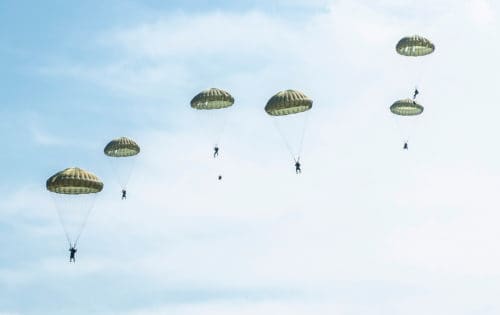Parachute fabric has to be flexible, lightweight, and durable, and there are several different materials that offer those benefits. Originally made of canvas, then silk, today’s parachutes may be made of ripstop nylon, terylene, or Kevlar, and manufacturers continue to innovate and experiment with materials to find the most effective, affordable, and reliable options for parachutes.
The material itself isn’t as important as what the material can do. Manufacturers look for certain characteristics when developing and using parachute fabrics.
Properties of Parachute Fabric
Parachutes have an important job to do, so the fabric must exhibit certain properties to ensure it can withstand the extreme environment while protecting the people wearing the parachute:
- Strength: The parachute fabric must resist the forces of gravity and drag over the course of hundreds or even thousands of falls. Strong, lightweight materials are easier to repack.
- Tear Resistance: Parachute fabric should resist corrosion and abrasion. A small tear can become a big problem mid-flight—to avoid this issue, ripstop nylon is woven in a regular crosshatch pattern to create small squares that serve to prevent a small tear from becoming larger.
- Elasticity: The fabric must open quickly, and elasticity helps distribute the load more evenly.
- Permeability: Tightly woven fabric helps prevent moisture and dirt from passing through it.
Materials Used in Parachute Fabric
Silk replaced canvas as a parachute fabric because it was lighter, more elastic, thinner, and easier to repack. When the silk supply ran low during World War II, nylon became a go-to choice for parachute fabric. The fact that it’s still used extensively today, even with the availability of options like Kevlar and Dacron, is a testament to its many favorable qualities:
- Elasticity
- Excellent strength-to-weight ratio
- Abrasion resistance
- Chemical resistance
- Wind resistance
- Fire resistance
- Mildew resistance
- Waterproof
- Lightweight
- Affordable
Ripstop nylon is specially woven to offer additional resistance against tearing. It’s available in a variety of colors, thicknesses, and textures ranging from silky to stiff, making it suitable not only for parachutes, but for tents, tarps, flags, banners, and even clothing. Because nylon is so strong, it’s also commonly used for parachute harness straps and other components as well.
For more than 80 years, nylon parachutes have been delivering people and packages safely to the ground. While fabric innovations continue, nylon remains a trusted, economical choice for parachute fabric.
HLC Parachute Supplier of Military-Grade and Commercial Aerial Delivery Systems
As the global leader in parachute fabric supply for both military and commercial aerial delivery systems, HLC is proud to be a fifth generation family company. For more than 100 years, our materials have been trusted in the most demanding and mission-critical applications for military, tactical, and industrial purposes. We’re committed to ongoing research and innovation to provide the best options for our clients. All of our fabrics are woven on state-of-the-art looms under ISO 9001 standards, and they’re finished and tested at U.S. government-certified facilities to ensure they’re safe and effective.
We’re known for creating high-quality products that meet extreme demands, and our customer service team is friendly and responsive. Contact us to learn more about our parachute fabrics, customized solutions, and long history as a leader in mil-spec fabrics, tactical nylon, and more.


